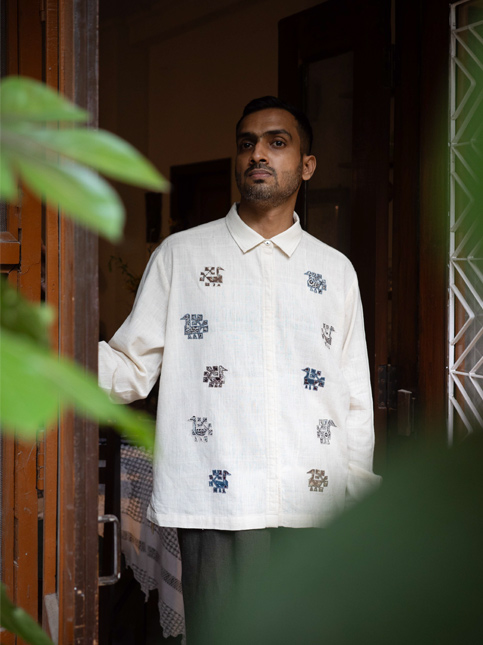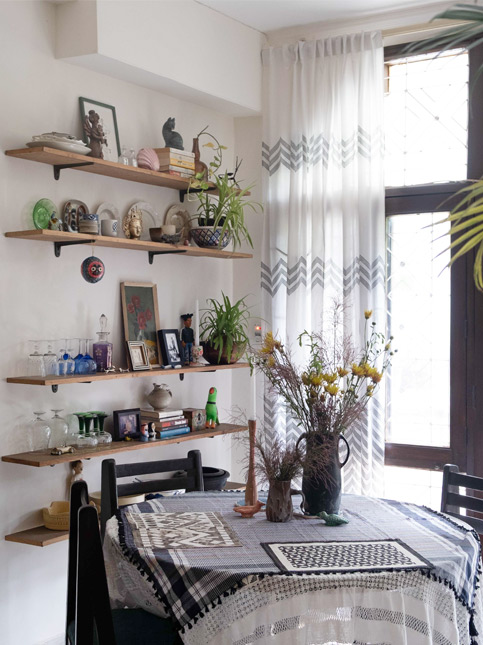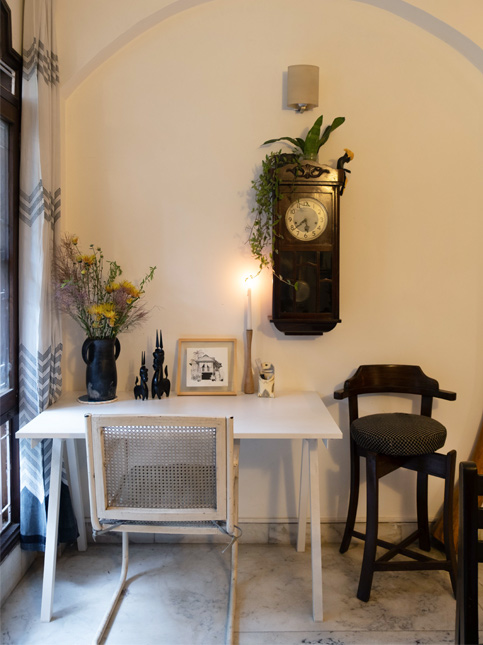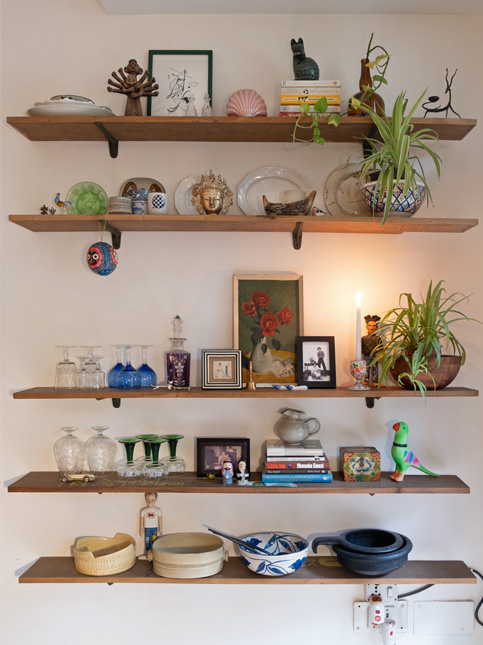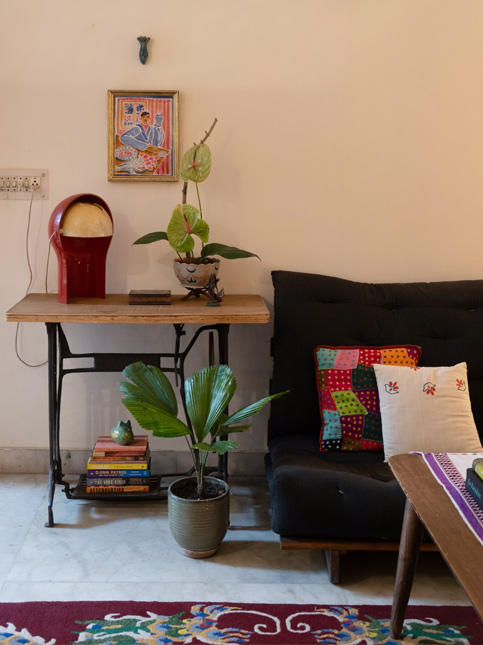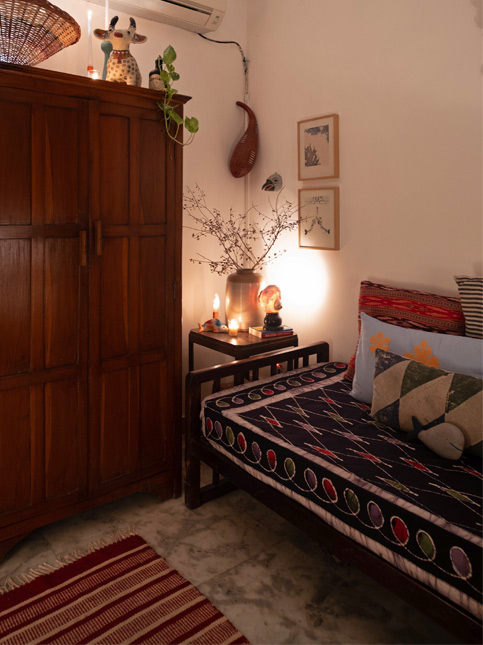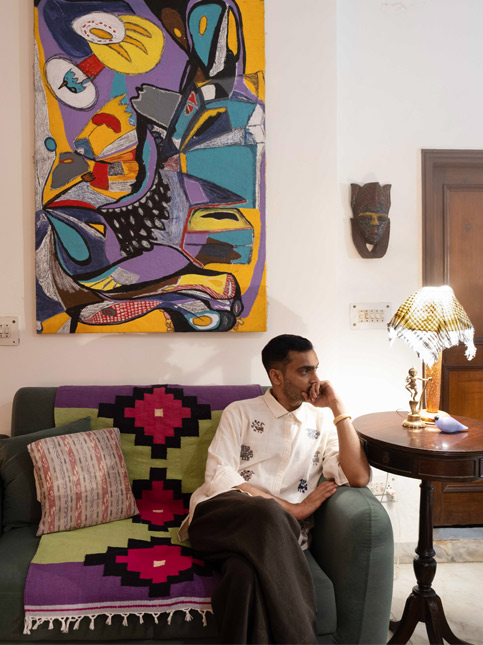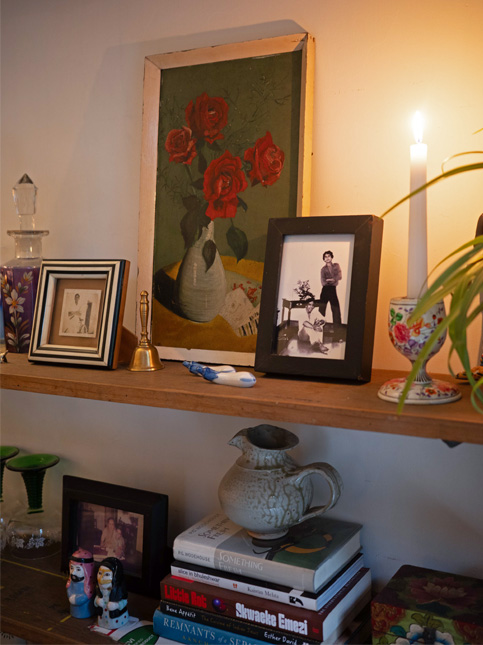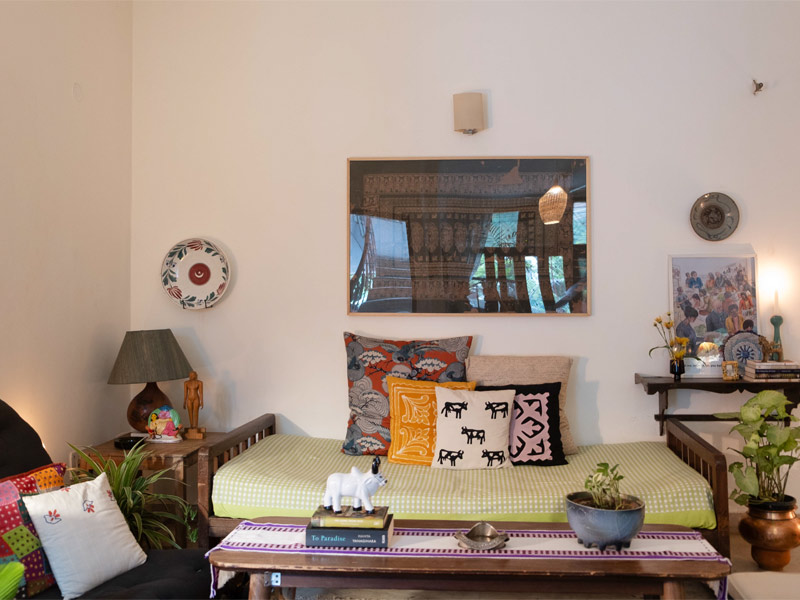Kitchens
- Category Name
- Kitchens
Get an approximate budget for your kitchen design by sharing your space details.
Speak to our design professionals
Share your info, we’ll book your slot.
Will you be living in your space during the renovation?
 Previous Question
Previous Question
 Previous Question
Previous Question
Please Select Date and Day
Appointment Date & time

From batik bedsheets to block-printed curtains and rescued furniture, Vidush Prabhakar’s home celebrates textile, texture, memory, and a quietly retro aesthetic
Vidush Prabhakar hunts for apartments the way some of us look for love: longingly, tenderly, with a touch of patience. Each time, he imagines his life unfolding across the rooms; a coffee table here, a corner there for his tall palm to lean into the sun, and his carefully accumulated textiles settling into place, draped or folded just so. “I remember this one house we saw, it had a silver-gold wallpapered basement with this weird niche that went nowhere. The kind of place you’d expect someone to stash a body,” he laughs.
After many such adventures, Vidush, head textile designer at Manan Design, landed in the homeliest rental: a ground-floor flat with a kitchen that instantly felt perfect, a dining area large enough to host all his friends without scraping elbows, and the promise of sun. He shares the space with a roommate who gives him free rein over the décor and, in return, tends to the neighbourhood cats, keeping bowls filled as they also make themselves at home. The false ceiling, ubiquitous in Delhi rentals, was absent and that was decisive. He loathes them.
Vidush’s education in fashion and his work with textiles show everywhere. Ikats he had woven. Blankets tan-dyed. Sheets dotted with small, perfect motifs. And then the animals, elephants, bullocks, dragons, wandering across cushions and rugs as if the house were their pasture. Curtains, block-printed by his own hands, fall in careful folds.
His design aesthetic is rooted in a refusal to let anything feel too “done”. Muted walls are his favourite that step back just enough for the furniture and objects to take the spotlight. “I spend hours rearranging till I get the harmony right,” he says about the layouts. Length, height, weight—all are considered, but never at the cost of variety. He shifts chairs, props cushions, moves rugs, noticing how the light falls across a surface, how one material might talk to another. He can’t abide a space that’s too uniform. “I’ll never put just one material, like a cluster of ceramics, without introducing something else to break it up; wood or brass, stone or shadow,” he adds as he shows me his purple beady chicken. His gallery walls are no different. Before the nails go in, everything is laid out on the floor, shifted, shuffled, nudged. He steps back. Adjusts again. Until it clicks.
This attention to balance and detail began in the rooms of his childhood home. When he was six or seven, in his Mangalore home, he remembers how the house was redone on a shoestring for his aunt’s wedding. Nothing new was bought. No major renovations. Mostly, things were reupholstered. Green velvet cushions became blue tartan checks. “This woke my mind up,” he says. “It also helped that my family cared about pure fabrics because Mangalore was too hot for blends.”
Even as a boy, he thus could tell Patola from Ikkat. He would pore over magazines, walk through fairs and exhibitions with his mother and grandmother, noticing patterns, textures, colours, and sometimes even be teased for it. When he moved from Mangalore to start living on his own, he took with him the trunks first. Hand-painted, heavy, full of family. His great-grandfather’s clock came along too, carrying its time. Every visit home added more: tables, chairs, crockery, textiles. “The family furniture has traveled north, west, and south. That black chair in my living room, for instance—it was my grandmother’s. It’s been to Jaipur, Calcutta, Bombay, Bangalore, Mangalore, and now, Delhi,” says the designer, who also has what he calls object memory. A lamp from his childhood, a curio long forgotten, he remembers these objects suddenly and rings up his mother, asking where it has gone, nudging at stories that belong to him as much as to the objects themselves.
Then there are things he collected along the way like the once hideous velvet couch that came with a rental. “I wanted to chuck it but my mother who was visiting stopped me before I could. ‘Let’s reupholster it,’ she said.” And he did. Now he loves it. One of his proudest finds is a tall, slim French round table, rescued from a raddiwala in Amar Colony for just 1,200 rupees.
The sewing machine turned console table, the batik printed bedsheets, block printed curtains and applique cushions makes the home feel as if it belonged in a Kodak roll from the 90s. “Visit exhibitions that bring together weavers from different states. Go to the government emporiums, you would be amazed at the treasures hiding in plain sight,” is his advice to anyone drawn to his style or doubts they still exist outside memory. He talks about a black-and-red batik sheet he picked up at a pre-Pujo sale at the Madhya Pradesh Emporium. “Look at it. How could anyone just pass it by? If you’re in Delhi, run to Delhi Haat or Dastkaar. Take a big empty tote, of course.” This is his retail therapy, the small way he lifts himself on days he feels flat. “You don’t need much. I got a stunning cushion cover recently for thirty-two rupees!” He smiles. “I love this city.”
In a home where every detail is curated, he realised one room could be left to the gentle anarchy of TV and lounging. This room came into being after a flatmate moved out. He has since discovered how perfect it is. A separate room where mess is allowed, where his obsession with keeping the common areas tidy doesn’t have to fight with the rest of the apartment.
Then there is hosting which brings constant rearrangement. Every dinner party reshapes the space: pots from the balcony are brought in, objects are pulled out from cupboards and dotted around the house, and corners are cleared to allow people to move or even dance. “There’s really nothing called indoor plants,” he says. “They all love the sun. I keep rotating them.” Friends sometimes notice the changes. Vidush loves it when this happens. He admits he is also a little thief, clipping branches from parks and streets. “I love fresh flowers, whole branches,” he says. They end up in vases, in corners, tucked into spaces he finds lonely.
Vidush’s home is a lesson in how to love objects and still not have a maximalist aesthetic. “I tend to rotate my things. I don’t have everything out at the same time. If I’ve had something out too long, or it feels like too much, I’ll swap it, put something else in its place. It’s fun because I rediscover old objects and I think, ‘Oh, I forgot about this!’ I also change carpets with the seasons. Heavier ones in winter, lighter in summer. Candles come out in the cold months. Throws, rugs, small details—they all shift with time and season, and it keeps the house feeling alive, balanced, and just the way I like it,” says the designer who is currently also working on his own line of textile and home linen.
Among his most treasured objects are those inherited from his grandmother: an oil painting of roses she painted, once suspended in the archway of their childhood home. Her signature remains, delicate and exact. He likes it for the way it hints at her obsession with arranging flowers, the little quiet compulsions that shape a life, ones he finds himself repeating here, decades later. Her Baluchari scarf, framed in the living room, catching the glare from the window, refusing to be photographed. He learned by watching her, Ikebana, the careful art of arranging flowers, and he carries that lesson into everything he does: placing objects on shelves, laying out furniture. It is all part of the same inheritance, a way of paying attention that turns living into a kind of flower arrangement, season into season.
All images by Menty Jamir
For expert design consultation, send us your details and we’ll schedule a call
Yes, I would like to receive important updates and notifications on WhatsApp.
By proceeding, you are authorizing Beautiful Homes and its suggested contractors to get in touch with you through calls, sms, or e-mail.
Our team will contact you for further details.
We were unable to receive your details. Please try submitting them again.




